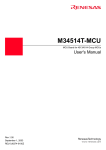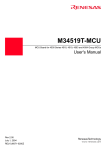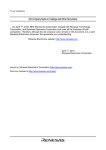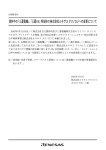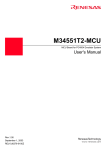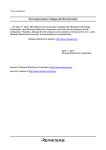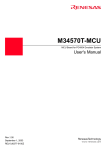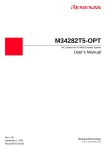Download Renesas 4513 Technical information
Transcript
To our customers, Old Company Name in Catalogs and Other Documents On April 1st, 2010, NEC Electronics Corporation merged with Renesas Technology Corporation, and Renesas Electronics Corporation took over all the business of both companies. Therefore, although the old company name remains in this document, it is a valid Renesas Electronics document. We appreciate your understanding. Renesas Electronics website: http://www.renesas.com April 1st, 2010 Renesas Electronics Corporation Issued by: Renesas Electronics Corporation (http://www.renesas.com) Send any inquiries to http://www.renesas.com/inquiry. Notice 1. 2. 3. 4. 5. 6. 7. All information included in this document is current as of the date this document is issued. Such information, however, is subject to change without any prior notice. Before purchasing or using any Renesas Electronics products listed herein, please confirm the latest product information with a Renesas Electronics sales office. Also, please pay regular and careful attention to additional and different information to be disclosed by Renesas Electronics such as that disclosed through our website. Renesas Electronics does not assume any liability for infringement of patents, copyrights, or other intellectual property rights of third parties by or arising from the use of Renesas Electronics products or technical information described in this document. No license, express, implied or otherwise, is granted hereby under any patents, copyrights or other intellectual property rights of Renesas Electronics or others. You should not alter, modify, copy, or otherwise misappropriate any Renesas Electronics product, whether in whole or in part. Descriptions of circuits, software and other related information in this document are provided only to illustrate the operation of semiconductor products and application examples. You are fully responsible for the incorporation of these circuits, software, and information in the design of your equipment. Renesas Electronics assumes no responsibility for any losses incurred by you or third parties arising from the use of these circuits, software, or information. When exporting the products or technology described in this document, you should comply with the applicable export control laws and regulations and follow the procedures required by such laws and regulations. You should not use Renesas Electronics products or the technology described in this document for any purpose relating to military applications or use by the military, including but not limited to the development of weapons of mass destruction. Renesas Electronics products and technology may not be used for or incorporated into any products or systems whose manufacture, use, or sale is prohibited under any applicable domestic or foreign laws or regulations. Renesas Electronics has used reasonable care in preparing the information included in this document, but Renesas Electronics does not warrant that such information is error free. Renesas Electronics assumes no liability whatsoever for any damages incurred by you resulting from errors in or omissions from the information included herein. Renesas Electronics products are classified according to the following three quality grades: “Standard”, “High Quality”, and “Specific”. The recommended applications for each Renesas Electronics product depends on the product’s quality grade, as indicated below. You must check the quality grade of each Renesas Electronics product before using it in a particular application. You may not use any Renesas Electronics product for any application categorized as “Specific” without the prior written consent of Renesas Electronics. Further, you may not use any Renesas Electronics product for any application for which it is not intended without the prior written consent of Renesas Electronics. Renesas Electronics shall not be in any way liable for any damages or losses incurred by you or third parties arising from the use of any Renesas Electronics product for an application categorized as “Specific” or for which the product is not intended where you have failed to obtain the prior written consent of Renesas Electronics. The quality grade of each Renesas Electronics product is “Standard” unless otherwise expressly specified in a Renesas Electronics data sheets or data books, etc. “Standard”: 8. 9. 10. 11. 12. Computers; office equipment; communications equipment; test and measurement equipment; audio and visual equipment; home electronic appliances; machine tools; personal electronic equipment; and industrial robots. “High Quality”: Transportation equipment (automobiles, trains, ships, etc.); traffic control systems; anti-disaster systems; anticrime systems; safety equipment; and medical equipment not specifically designed for life support. “Specific”: Aircraft; aerospace equipment; submersible repeaters; nuclear reactor control systems; medical equipment or systems for life support (e.g. artificial life support devices or systems), surgical implantations, or healthcare intervention (e.g. excision, etc.), and any other applications or purposes that pose a direct threat to human life. You should use the Renesas Electronics products described in this document within the range specified by Renesas Electronics, especially with respect to the maximum rating, operating supply voltage range, movement power voltage range, heat radiation characteristics, installation and other product characteristics. Renesas Electronics shall have no liability for malfunctions or damages arising out of the use of Renesas Electronics products beyond such specified ranges. Although Renesas Electronics endeavors to improve the quality and reliability of its products, semiconductor products have specific characteristics such as the occurrence of failure at a certain rate and malfunctions under certain use conditions. Further, Renesas Electronics products are not subject to radiation resistance design. Please be sure to implement safety measures to guard them against the possibility of physical injury, and injury or damage caused by fire in the event of the failure of a Renesas Electronics product, such as safety design for hardware and software including but not limited to redundancy, fire control and malfunction prevention, appropriate treatment for aging degradation or any other appropriate measures. Because the evaluation of microcomputer software alone is very difficult, please evaluate the safety of the final products or system manufactured by you. Please contact a Renesas Electronics sales office for details as to environmental matters such as the environmental compatibility of each Renesas Electronics product. Please use Renesas Electronics products in compliance with all applicable laws and regulations that regulate the inclusion or use of controlled substances, including without limitation, the EU RoHS Directive. Renesas Electronics assumes no liability for damages or losses occurring as a result of your noncompliance with applicable laws and regulations. This document may not be reproduced or duplicated, in any form, in whole or in part, without prior written consent of Renesas Electronics. Please contact a Renesas Electronics sales office if you have any questions regarding the information contained in this document or Renesas Electronics products, or if you have any other inquiries. (Note 1) “Renesas Electronics” as used in this document means Renesas Electronics Corporation and also includes its majorityowned subsidiaries. (Note 2) “Renesas Electronics product(s)” means any product developed or manufactured by or for Renesas Electronics. User’s Manual M34514T-MCU User’s Manual MCU Board for 4513/4514 Group MCUs Rev.1.00 2003.09 * MS-DOS is a registered trademark of Microsoft Corporation. * IBM and AT are registered trademarks of International Business Machines Corporation. * NQPACK, YQPACK, YQSOCKET, YQ-GUIDE, HQPACK, TQPACK and TQSOCKET are trademarks of Tokyo Eletech Corporation. Keep safety first in your circuit designs! • Renesas Technology Corporation and Renesas Solutions Corporation put the maximum effort into making semiconductor products better and more reliable, but there is always the possibility that trouble may occur with them. Trouble with semiconductors may lead to personal injury, fire or property damage. Remember to give due consideration to safety when making your circuit designs, with appropriate measures such as (i) placement of substitutive, auxiliary circuits, (ii) use of nonflammable material or (iii) prevention against any malfunction or mishap. Notes regarding these materials • These materials are intended as a reference to assist our customers in the selection of the Renesas Technology product best suited to the customer's application; they do not convey any license under any intellectual property rights, or any other rights, belonging to Renesas Technology Corporation, Renesas Solutions Corporation or a third party. • Renesas Technology Corporation and Renesas Solutions Corporation assume no responsibility for any damage, or infringement of any third-party's rights, originating in the use of any product data, diagrams, charts, programs, algorithms, or circuit application examples contained in these materials. • All information contained in these materials, including product data, diagrams, charts, programs and algorithms represents information on products at the time of publication of these materials, and are subject to change by Renesas Technology Corporation and Renesas Solutions Corporation without notice due to product improvements or other reasons. It is therefore recommended that customers contact Renesas Technology Corporation, Renesas Solutions Corporation or an authorized Renesas Technology product distributor for the latest product information before purchasing a product listed herein. The information described here may contain technical inaccuracies or typographical errors. Renesas Technology Corporation and Renesas Solutions Corporation assume no responsibility for any damage, liability, or other loss rising from these inaccuracies or errors. Please also pay attention to information published by Renesas Technology Corporation and Renesas Solutions Corporation by various means, including the Renesas home page (http://www.renesas.com). • When using any or all of the information contained in these materials, including product data, diagrams, charts, programs, and algorithms, please be sure to evaluate all information as a total system before making a final decision on the applicability of the information and products. Renesas Technology Corporation and Renesas Solutions Corporation assume no responsibility for any damage, liability or other loss resulting from the information contained herein. • Renesas Technology semiconductors are not designed or manufactured for use in a device or system that is used under circumstances in which human life is potentially at stake. Please contact Renesas Technology Corporation, Renesas Solutions Corporation or an authorized Renesas Technology product distributor when considering the use of a product contained herein for any specific purposes, such as apparatus or systems for transportation, vehicular, medical, aerospace, nuclear, or undersea repeater use. • The prior written approval of Renesas Technology Corporation and Renesas Solutions Corporation is necessary to reprint or reproduce in whole or in part these materials. • If these products or technologies are subject to the Japanese export control restrictions, they must be exported under a license from the Japanese government and cannot be imported into a country other than the approved destination. Any diversion or reexport contrary to the export control laws and regulations of Japan and/or the country of destination is prohibited. • Please contact Renesas Technology Corporation or Renesas Solutions Corporation for further details on these materials or the products contained therein. Precautions to be taken when using this product • This product is a development supporting unit for use in your program development and evaluation stages. In mass-producing your program you have finished developing, be sure to make a judgment on your own risk that it can be put to practical use by performing integration test, evaluation, or some experiment else. • In no event shall Renesas Solutions Corporation be liable for any consequence arising from the use of this product. • Renesas Solutions Corporation strives to renovate or provide a workaround for product malfunction at some charge or without charge. However, this does not necessarily mean that Renesas Solutions Corporation guarantees the renovation or the provision under any circumstances. • This product has been developed by assuming its use for program development and evaluation in laboratories. Therefore, it does not fall under the application of Electrical Appliance and Material Safety Law and protection against electromagnetic interference when used in Japan. For inquiries about the contents of this document or product, fill in the text file the installer of the emulator debugger generates in the following directory and email to your local distributor. \SUPPORT\Product-name\SUPPORT.TXT Renesas Tools Homepage http://www.renesas.com/en/tools ( 2 / 42 ) Contents Preface .................................................................................................................................... 4 1. Precautions for Safety ......................................................................................................... 5 1.1 Safety Symbols and Meanings .............................................................................. 5 2. Handling Precautions .......................................................................................................... 9 3. Contents of the M34514T-MCU Package ........................................................................ 11 3.1 Things to Check When Unpacking ..................................................................... 11 3.2 Other Necessary Products ................................................................................... 11 4. M34514T-MCU ................................................................................................................ 13 4.1 Outline ................................................................................................................. 13 4.2 Specifications ...................................................................................................... 15 4.3 Description of Switches ...................................................................................... 16 4.4 Description of Connectors ................................................................................... 18 4.5 Connection to the Target System ........................................................................ 21 4.6 LED ..................................................................................................................... 27 5. Precautions to Be Taken When Debugging ...................................................................... 29 5.1 Reset .................................................................................................................... 29 5.2 System Clock ...................................................................................................... 29 5.3 Real-time Capability of Timer ............................................................................ 29 5.4 Watchdog Timer .................................................................................................. 30 5.5 Pullup Transistor Control .................................................................................... 30 5.6 Port I/O Timing ................................................................................................... 31 5.7 Port I/O Characteristics ....................................................................................... 32 5.8 Power-down Mode .............................................................................................. 33 5.9 Program Execution (G, GB) ................................................................................ 34 5.10 External Trigger Signal ..................................................................................... 36 6. Connection Circuit Diagram ............................................................................................. 37 7. Pitch Converter Board External Dimensions ................................................................... 39 7.1 M34513T-PTCA ................................................................................................. 39 7.2 M34513T-PTCB ................................................................................................. 39 7.3 M34513T-PTCC ................................................................................................. 39 Appendix A. How to Request for Repair ............................................................................. 40 ( 3 / 42 ) Preface This user's manual describes the specifications of the M34514T-MCU emulator board for Renesas 4513/4514 Group of 4-bit single-chip microcomputers. M34514T-MCU is an MCU board for the PC4504 emulator. For the PC4504 emulator main unit and the M3T-PD45 emulator debugger, refer to each user's manual. To use the product properly Precautions for Safety • In both this User's Manual and on the product itself, several icons are used to insure proper handling of this product and also to prevent injuries to you or other persons, or damage to your properties. • The icons' graphic images and meanings are given in "Chapter 1. Precautions for Safety". Be sure to read this chapter before using the product. ( 4 / 42 ) Chapter 1. Precautions for Safety In both the user's manual and on the product itself, several icons are used to insure proper handling of this product and also to prevent injuries to you or other persons, or damage to your properties. This chapter describes the precautions which should be taken in order to use this product safely and properly. Be sure to read this chapter before using this product. 1.1 Safety Symbols and Meanings WARNING If the requirements shown in the "WARNING" sentences are ignored, the equipment may cause serious personal injury or death. CAUTION If the requirements shown in the "CAUTION" sentences are ignored, the equipment may malfunction. IMPORTANT It means important information on using this product. In addition to the three above, the following are also used as appropriate. means WARNING or CAUTION. Example: CAUTION AGAINST AN ELECTRIC SHOCK means PROHIBITION. Example: DISASSEMBLY PROHIBITED means A FORCIBLE ACTION. Example: UNPLUG THE POWER CABLE FROM THE RECEPTACLE. The following pages describe the symbols "WARNING", "CAUTION", and "IMPORTANT". ( 5 / 42 ) WARNING Warning for Installation: • Do not set this product in water or areas of high humidity. Make sure that the main unit does not get wet. Spilling water or some other liquid into the main unit can cause an unrepairable damage. Warning for Use Environment: • This equipment is to be used in an environment with a maximum ambient temperature of 35°C. Care should be taken that this temperature is not exceeded. CAUTION Cautions to Be Taken for This Product: • Do not disassemble or modify this product. Disassembling or modifying this product can cause damage. Disassembling and modifying the product will void your warranty. • Use caution when handling the main unit. Be careful not to apply a mechanical shock. • Do not pull the emulator probe (100-wire half-pitch cable or 50-wire normal-pitch cable) to disconnect from the emulator main unit. • Do not use inch-size screws for this equipment. The screws used in this equipment are all ISO (meter-size) type screws. When replacing screws, use same type screws as equipped before. ( 6 / 42 ) IMPORTANT Notes on Differences between Actual MCU and Emulator: • Emulator operation differs from emulation of a mask MCU, as listed below. For details refer to "Chapter 5. Precautions to Be Taken When Debugging". (1) Reset condition (2) Initial values of internal resource data at power-on (3) Internal ROM and RAM capacities, etc. (4) Electrical characteristics (5) Operation in the power-down mode (6) Operation of the watchdog timer function (7) Port I/O Timing (8) Pullup transistor control • Therefore, always be sure to evaluate your system with an evaluation MCU (onetime version). Also, be sure to perform board-mounted evaluation with ES (Engineering Sample) version MCU to make final confirmation of device operation before starting mask production. Note on the Target System: • Make sure that the target's supply voltage is + 3.0 V or + 5.0 V. Therefore the target's supply voltage should be in the range of + 3.0 V ±10% or + 5.0 V ±10%. Notes on Connecting the Target System: • When connecting the emulator probe, be careful to the wrong connection. • When connecting the emulator probe, be careful to the warp of the cable. The warp may cause breaking the wire. ( 7 / 42 ) MEMO ( 8 / 42 ) 2. Handling Precautions When using the M34514T-MCU board, pay attention to the following: (1) About the emulator To use the M34514T-MCU board, you always need to install it on the PC4504 emulator main unit. (2) About the MCU board installation Before installing (and removing) the MCU board, always be sure to power off the PC4504 emulator main unit and unplug its power cord from the outlet. For details on how to install and remove the MCU board, see "Chapter 2. Setup" in the PC4504 System User's Manual. (3) Emulator debugger (M3T-PD45) When using the M34514T-MCU board to debug your program, you need the M3T-PD45 emulator debugger (sold separately). Be sure to use the data file for 4513 or 4514 Group included with the M3T-PD45 emulator debugger. (4) Registers that can be operated from M3T-PD45 Table 2.1 lists the registers that can be operated from M3T-PD45 for 4514 Group MCUs. The "Yes" in the table means that the register can be operated; the "No" means that the register can not be operated. Table 2.1 Registers that can be operated for 4514 Group MCUs Register Reference Modification Register Reference Modification PC Yes Yes W1 Yes Yes CY Yes Yes W2 Yes Yes A Yes Yes W3 Yes Yes B Yes Yes W4 Yes Yes X Yes Yes W6 Yes Yes Y Yes Yes J1 Yes Yes Z Yes Yes Q1 Yes Yes D Yes Yes Q2 Yes Yes E Yes Yes Q3 Yes Yes SP Yes No K0 Yes Yes V1 Yes Yes PU0 Yes Yes V2 Yes Yes FR0 No Yes I1 Yes Yes MR Yes Yes I2 Yes Yes R1 No Yes SI Yes Yes R2 No Yes LA Yes No R3 No Yes HA Yes Yes R4 No Yes ( 9 / 42 ) Table 2.2 lists the registers that can be operated from M3T-PD45 for 4513 Group MCUs. The "Yes" in the table means that the register can be operated; the "No" means that the register can not be operated. Table 2.2 Registers that can be operated for 4513 Group MCUs Register Reference Modification Register Reference Modification PC Yes Yes W1 Yes Yes CY Yes Yes W2 Yes Yes A Yes Yes W3 Yes Yes B Yes Yes W4 Yes Yes X Yes Yes W6 Yes Yes Y Yes Yes J1 Yes Yes Z Yes Yes Q1 Yes Yes D Yes Yes Q2 Yes Yes E Yes Yes Q3 Yes Yes SP Yes No K0 Yes Yes V1 Yes Yes PU0 Yes Yes V2 Yes Yes MR Yes Yes I1 Yes Yes R1 No Yes I2 Yes Yes R2 No Yes SI Yes Yes R3 No Yes R4 No Yes LA Yes No HA Yes Yes ( 10 / 42 ) 3. Contents of the M34514T-MCU Package 3.1 Things to Check When Unpacking Table 3.1 shows the contents of the M34514T-MCU package. When unpacking your M34514TMCU package, check to see that all of these components are included. Table 3.1 Contents of M34514T-MCU Item Product name Quantity 1 M34514T-MCU 1 2 100-wire half-pitch cable (40 cm) 1 3 50-wire normal-pitch cable (10 cm) 1 4 2-wire cable for external trigger signal (50 cm) 1 5 PCA4029 pitch converter board 1 6 OSC-2 oscillator circuit board (J1 connector mounted) *1 1 7 M34513T-PTCA pitch converter board 1 8 M34513T-PTCB pitch converter board 1 9 M34513T-PTCC pitch converter board *2 1 10 M34514T-MCU English user's manual (this manual) 1 *1 M34514T-MCU has an oscillator circuit board OSC-2 (for 4.19 MHz) that is incorporated when shipped from the factory. In addition, it comes with an oscillator circuit board OSC-2, with only a connector J1 mounted. *2 M34513T-PTCC consists of M34513T-PTCC and TQPACK. *3 Keep the packaging carton and cushion material of the M34514T-MCU to transport it for repair or for other purposes in the future. *4 If you find any item missing or faulty, or any suggestion, contact your local distributor. 3.2 Other Necessary Products To bring forward programs development on the 4513/4514 Group of 4-bit microcomputers, the products given below are necessary in addition to those contained in the package above. Get them separately to be ready when necessary. (1) Emulator main unit: PC4504 (2) Emulator debugger: M3T-PD45 (3) Programming adapter: PCA7441 (for 4514 Group SSOP) PCA7442FP (for 4513 Group LQFP) PCA7442SP (for 4513 Group SDIP) ( 11 / 42 ) MEMO ( 12 / 42 ) 4. M34514T-MCU 4.1 Outline By using with the PC4504 emulator main unit, M34514T-MCU can make up an emulator system which can be operated by a personal computer. Figure 4.1 shows the development support system configuration for 4514 Group MCUs. Figure 4.1 Development support system configuration for 4514 Group MCUs ( 13 / 42 ) Figure 4.2 shows the development support system configuration for 4513 Group MCUs. Figure 4.2 Development support system configuration for 4513 Group MCUs *1 Use the M34513T-PTCA pitch converter board for 32SDIP. *2 Use the M34513T-PTCA, M34513T-PTCB and M34513T-PTCC pitch converter boards for 32LQFP. For more details, refer to "4.5 Connection to the Target System". ( 14 / 42 ) 4.2 Specifications Table 4.1 lists specifications of M34514T-MCU. Table 4.1 M34514T-MCU Specifications Applicable MCUs M34513MX-XXXFP/SP, M34513EX-XXXFP/SP M34514MX-XXXFP, M34514E8-XXXFP Evaluation MCU Maximum operating clock frequency M34514E8FP (mounted) 3V Medium-speed mode*1: High-speed mode: 4.2 MHz 2.0 MHz 5V Medium-speed mode*1: High-speed mode: 4.2 MHz 4.2 MHz Target system voltage 3 V or 5 V Power supply Supplied by the PC4504's internal power supply (+5 V, +12 V) Port emulation Port Output type Direction Device used N-channel open drain Input/output Input: 74HC4050 Output: 74LS06 D0 to D5 P00 to P03 P10 to P13 P21/SOUT P22/SIN Board dimensions Input/Output: 74HC4066 - Input Input: 74HC4050 233 (L) x 135 (W) x 26 (H) mm Operating temperature 5 to 35°C (non-condensing) Product configuration M34514T-MCU 100-wire half-pitch cable 50-wire normal-pitch cable External trigger cable PCA4029 OSC-2 (for changing frequencies) *2 M34513T-PTCA M34513T-PTCB M34513T-PTCC*3 *1 M34514T-MCU operates at the medium-speed mode (instruction-clock f (XIN)/6) immediately after a RESET is released. *2 M34514T-MCU has an oscillator circuit board OSC-2 (for 4.19 MHz) that is incorporated when shipped from the factory. In addition, it comes with an oscillator circuit board OSC-2, with only a connector J1 mounted. *3 M34513T-PTCC consists of M34513T-PTCC and TQPACK. ( 15 / 42 ) 4.3 Description of Switches The M34514T-MCU board has eight switches. Figure 4.3 shows the positions of these switches. Tables 4.2 and 4.3 list the functions of the switches and the preset switch positions that are set before the MCU board is shipped from the factory. For the products with the following lot numbers, the position of SW8 is here: 8FS001 - 8FS005, 8GS006 - 8GS020, 8KS021 - 8KS040, 9AS001 - 9AS020, 9CS021 - 9CS060, 9GS061 - 9GS090, 9JS091 - 9JS140 Figure 4.3 Positions of switches Table 4.2 Functions of switches (1/2) Description Switch position Label OFF ON OFF Does not connect the VDD of the M34514TMCU to the VDD of the target system. ON ON OFF Connects the VDD of the M34514T-MCU to the VDD of the target system. Factory-setting SW1 SW2 Set the MCU’s ROM size. • Set "2" (M2) • Set "4" (M4) • Set "6" (M6) • Set "8" (M8) ROMSIZE 5V 3V 5V Operates the target MCU at +5 V. 3V 3V 5V Operates the target MCU at + 3 V. OFF 8 SW3 ( 16 / 42 ) 5V Table 4.3 Functions of switches (2/2) Description Switch position Label Factory-setting ON Does not connect the pullup resistor 68 kΩ to the ports P00 and P01. OFF OFF SW4 ON Connects the pullup resistor 68 kΩ to the ports P00 and P01. ON OFF OFF ON Does not connect the pullup resistor 68 kΩ to the ports P02 and P03. OFF OFF SW5 ON Connects the pullup resistor 68 kΩ to the ports P02 and P03. ON OFF OFF ON Does not connect the pullup resistor 68 kΩ to the ports P10 and P11. OFF OFF SW6 ON Connects the pullup resistor 68 kΩ to the ports P10 and P11. ON OFF OFF ON Does not connect the pullup resistor 68 kΩ to the ports P12 and P13. OFF OFF SW7 ON Connects the pullup resistor 68 kΩ to the ports P12 and P13. ON OFF OFF 514 513 514 Operates for 4514 Group. 513 513 514 Operates for 4513 Group. SW8 ( 17 / 42 ) 514 4.4 Description of Connectors The M34514T-MCU board has five connectors. Table 4.4 lists the functions of these connectors. Figure 4.4 shows the positions of connectors on the MCU board. Table 4.4 Connectors Connector Function J1 Connects the evaluation MCU bus. J2 Connects the monitor CPU bus. J3 Connects the target system. (100-pin) J4 Connects the external trigger signal. (2-pin) J6 Connects the oscillator circuit board. (4-pin) Figure 4.4 Positions of the connectors ( 18 / 42 ) (1) Connector J3 Table 4.5 lists the pin assignments of the 100-wire half-pitch connector (J3) for connecting the PCA4029. And Figure 4.5 shows the connector J3 pin layout. Table 4.5 Pin assignments of the connector J3 Line A Pin No. Signal 1 2 Line B I/O Pin No. Signal GND 1 GND 2 3 GND 4 5 Line C I/O Line D Pin No. Signal I/O Pin No. Signal I/O GND 1 EP13 I/O 1 EP12 I/O GND 2 ED0 I/O 2 EP11 I/O 3 GND 3 ED1 I/O 3 EP10 I/O GND 4 GND 4 ED2 I/O 4 EP03 I/O GND 5 GND 5 ED3 I/O 5 EP02 I/O 6 GND 6 GND 6 ED4 I/O 6 EP01 I/O 7 GND 7 GND 7 ED5 I/O 7 EP00 I/O 8 GND 8 GND 8 D6/CNTR0 I/O 8 P43/AIN7 I/O 9 GND 9 GND 9 D7/CNTR1 I/O 9 P42/AIN6 I/O 10 GND 10 GND 10 P50 I/O 10 P41/AIN5 I/O 11 GND 11 GND 11 P51 I/O 11 P40/AIN4 I/O 12 GND 12 GND 12 P52 I/O 12 AIN3/COM1+ I 13 GND 13 GND 13 P53 I/O 13 AIN2/COM1- I 14 GND 14 GND 14 P20/SCK I/O 14 AIN1/COM0+ I 15 GND 15 GND 15 P21/SOUT I/O 15 AIN0/COM0- I 16 GND 16 GND 16 P22/SIN I 16 P33 I/O 17 GND 17 GND 17 RESET I 17 P32 I/O 18 GND 18 GND 18 CNVSS - 18 P31/INT1 I/O 19 GND 19 GND 19 XOUT - 19 P30/INT0 I/O 20 GND 20 GND 20 XIN - 20 VDCE I 21 GND 21 GND 21 VSS 21 VDD 22 GND 22 GND 22 NC - 22 NC - 23 GND 23 GND 23 NC - 23 NC - 24 GND 24 GND 24 NC - 24 NC - 25 GND 25 GND 25 NC - 25 NC - Note: "I" in the direction column denotes "Input"; "O" denotes "Output"; "I/O" denotes "Input/ output"; "-" denotes "Not connected". Figure 4.5 Connector J3 pin layout ( 19 / 42 ) (2) Connector J4 To use the external trigger signal as event input of trigger breaks or trace points, connect the 2wire external trigger signal cable included with your M34514T-MCU board to the connector J4. Connect the black clip of the external trigger cable to GND, and use the white clip for external trigger signal input. Table 4.6 lists the pin assignments of the connector J4. Table 4.6 Pin assignments of connector J4 Pin No. Signal Function 1 TRIG External trigger signal input 2 GND GND input (3) Connector J6 The connector J6 is a connector used to connect an oscillator circuit board OSC-2. Table 4.7 lists the pin assignments of the connector J6. Figure 4.6 shows the pin layout of the connector J6. For the 4.19 MHz operation with the oscillator circuit board OSC-2, see Figure 4.7. Table 4.7 Pin assignments of connector J6 Pin No. Signal Function 1 VCC Power supply 2 GND GND 3 CLK Clock input 4 GND GND Figure 4.6 Pin layout of connector J6 Figure 4.7 Circuit diagram of OSC-2 oscillator circuit board (4.19 MHz) ( 20 / 42 ) 4.5 Connection to the Target System (1) For 4514 Group When connecting the M34514T-MCU board to the target system: a. Connecting to 2.54-mm-pitch Dual-in-line Pins on the Target System Use the 50-wire normal-pitch cable (included) to connect the 50-pin dual-in-line pins on the target system. Following products are required for connection to the target system. • 100-wire half-pitch cable (40 cm) • PCA4029 pitch converter board • 50-wire normal-pitch cable (10 cm) Figure 4.8 depicts the M34514T-MCU board connected to the target system using the 50-wire normal-pitch cable. Table 4.8 lists the connector signal assignments of the 50-wire normal-pitch cable. Figure 4.9 shows the pin layout of the 50-wire normal-pitch cable. Figure 4.8 Connection to the target system using dual-in-line pins ( 21 / 42 ) Table 4.8 50-wire normal-pitch cable pin assignments 50-wire normal-pitch cable Pin No. Signal Pin No. Signal 1 EP13 50 EP12 2 ED0 49 EP11 3 ED1 48 EP10 4 ED2 47 EP03 5 ED3 46 EP02 6 ED4 45 EP01 7 ED5 44 EP00 8 D6/CNTR0 43 P43/AIN7 9 D7/CNTR1 42 P42/AIN6 10 P50 41 P41/AIN5 11 P51 40 P40/AIN4 12 P52 39 AIN3/COM1+ 13 P53 38 AIN2/COM1- 14 P20/SCK 37 AIN1/COM0+ 15 P21/SOUT 36 AIN0/COM0- 16 P22/SIN 35 P33 17 RESET 34 P32 18 NC (CNVSS) 33 P31/INT1 19 NC (XOUT) 32 P30/INT0 20 NC (XIN) 31 VDCE 21 VSS 30 VDD 22 NC 29 NC 23 NC 28 NC 24 NC 27 NC 25 NC 26 NC Figure 4.9 Pin layout of 50-wire normal-pitch cable ( 22 / 42 ) (2) For 4513 Group When connecting the M34514T-MCU board to the target system (for 4513 Group): a. Connecting to the IC socket for 32-pin SDIP on the Target System Connect the M34514T-MCU board with the IC socket for 32-pin SDIP on the target system using the 50-wire normal-pitch cable (included) with the M34513T-PTCA pitch converter board attached. Figure 4.10 depicts the connection between the M34513T-PTCA pitch converter board and the target system. Following products are required for connection to the target system. • 100-wire half-pitch cable (40 cm) • PCA4029 pitch converter board • 50-wire normal-pitch cable (10 cm) • M34513T-PTCA pitch converter board Table 4.9 shows the connector signal assignments of the M34513T-PTCA pitch converter board. The pin assignments of M34513T-PTCA is the same as for the 32SDIP in 4513 Group. When connecting the M34513T-PTCA pitch converter board, make sure the No. 1 pin position of each connector is aligned with that of cable. To avoid damage to the emulator and target system, be careful of the connection. Figure 4.10 Connecting to IC socket for 32-pin SDIP ( 23 / 42 ) Table 4.9 M34513T-PTCA pin assignments M34513T-PTCA J2 Pin No. Signal Pin No. Signal 1 ED0 32 EP13 2 ED1 31 EP12 3 ED2 30 EP11 4 ED3 29 EP10 5 ED4 28 EP03 6 ED5 27 EP02 7 D6/CNTR0 26 EP01 8 D7/CNTR1 25 EP00 9 P20/SCK 24 AIN3/COM1+ 10 P21/SOUT 23 AIN2/COM1- 11 P22/SIN 22 AIN1/COM0+ 12 RESET 21 AIN0/COM0- 13 CNVSS 20 P31/INT1 14 XOUT 19 P30/INT0 15 XIN 18 VDCE 16 VSS 17 VDD ( 24 / 42 ) b. When Connecting to a 32-pin LQFP Foot Pattern on the Target System Attach the pitch converter boards M34513T-PTCA and M34513T-PTCB to the 50-pin normalpitch cable (included with this product). Then connect the cable via the M34513T-PTCC to the TQPACK032SA that has been soldered to the 32-pin LQFP foot pattern on the target system. Figure 4.11 shows an example of how to connect to the target system using the M34513T-PTCA, M34513T-PTCB, and M34513T-PTCC. Following products are required for connection to the target system: • 100-wire half-pitch cable (40 cm) • PCA4029 pitch converter board • 50-wire normal-pitch cable (10 cm) • M34513T-PTCA pitch converter board • M34513T-PTCB pitch converter board • M34513T-PTCC pitch converter board (TQPACK* included) * TQPACK consists of TQSOCKET032AF, TQSOCKET032SAP and TQPACK032SA. Table 4.10 shows the connector signal assignments of the TQPACK032SA. When the TQPACK032SA and M34513T-PTCC are used for target system connection, the pin assignments are the same as for the 32LQFP in 4513 Group. Solder the TQPACK032SA to the 32-pin LQFP foot pattern on the target system. The No. 1 pin of the TQPACK032SA is located at its corner-cut part of package. Attach the M34513T-PTCC to the TQPACK032SA with its No. 1 pin position (marked by a white dot) aligned with that of the TQPACK032SA. After attaching the pitch converter boards M34513T-PTCA and M34513TPTCB to the 50-pin normal-pitch cable, connect the cable to the M34513T-PTCC. To avoid damage to the emulator and target system, be careful of the connection. When connecting cable and attaching the pitch converter boards, make sure the No. 1 pin position of each connector is aligned with that of cable. Figure 4.12 shows the external view of the TQPACK032SA and M34513T-PTCC. Figure 4.11 Connecting to 32-pin LQFP foot pattern on target system ( 25 / 42 ) Table 4.10 TQPACK032SA pin assignments TQPACK pin No. Pin No. Signal Pin No. Signal 1 ED3 32 ED2 2 ED4 31 ED1 3 ED5 30 ED0 4 D6/CNTR0 29 EP13 5 D7/CNTR1 28 EP12 6 P20/SCK 27 EP11 7 P21/SOUT 26 EP10 8 P22/SIN 25 EP03 9 RESET 24 EP02 10 CNVSS 23 EP01 11 XOUT 22 EP00 12 XIN 21 AIN3/COM1+ 13 VSS 20 AIN2/COM1- 14 VDD 19 AIN1/COM0+ 15 VDCE 18 AIN0/COM0- 16 P30/INT0 17 P31/INT1 Figure 4.12 External view of TQPACK032SA and M34513T-PTCC ( 26 / 42 ) Some signals connected to the target system are emulated on the M34514T-MCU board. For details, see "Chapter 6. Connection Circuit Diagram". (1) Pins connected directly to the target system (8 types, 21 lines) • P30 to P33*1 • P40 to P43*1 • P50 to P53*1 • P20 • D6, D7 • AIN0 to AIN3 • VDCE • VSS *1 For 4513 Group MCUs, the ports P32, P33, P40 to P43 and P50 to P53 can not be connected to the target system. (2) Pins connected to the target system via emulation circuits etc. (6 types, 18 lines) • P00 to P03 • P10 to P13 • P21 to P22 • D0 to D5 • RESET* • VDD (3) Pins not connected to the target system (3 types, 3 lines) • XIN • XOUT • CNVSS 4.6 LED Figure 4.13 shows the LED layout of M34514T-MCU. The LED lights in green when the power is supplied to the MCU board. Figure 4.13 Layout of LED ( 27 / 42 ) MEMO ( 28 / 42 ) 5. Precautions to Be Taken When Debugging 5.1 Reset The M34514T-MCU uses a 74AC14 for its RESET signal input buffer, so that its electrical characteristics differ from those of the actual chip. Table 5.1 lists the RESET signal input characteristics of the M34514T-MCU. Table 5.1 RESET signal input characteristics Item H-level threshold voltage L-level threshold voltage Hysteresis voltage Symbol VP VN VH Voltage Minimum Maximum VCC = 3.0 V - 2.2 V VCC = 4.5 V - 3.2 V VCC = 5.5 V - 3.9 V VCC = 3.0 V 0.5 V - VCC = 4.5 V 0.9 V - VCC = 5.5 V 1.1 V - VCC = 3.0 V 0.3 V 1.2 V VCC = 4.5 V 0.4 V 1.4 V VCC = 5.5 V 0.5 V 1.6 V 5.2 System Clock Depending on the supply voltage and operation mode, use one of the following frequencies for the system clock: • Supply voltage 5 V: 4.2 MHz or less (medium-speed/high-speed mode) • Supply voltage 3 V: 4.2 MHz or less (medium-speed mode), 2.0 MHz or less (high-speed mode) To change this clock frequency to suit that of the target system, attach the necessary parts to the oscillator circuit board OSC-2 that are included with the M34514T-MCU package. For details about the oscillation circuit constant, consult your oscillator manufacturer. 5.3 Real-time Capability of Timer The PC4504 and M34514T-MCU have their internal clock operating even during emulation, so that the timer values keep changing. Example: (1) When single-stepping the program (2) When registers or internal RAM are referenced or modified ( 29 / 42 ) 5.4 Watchdog Timer The M34514T-MCU does not have an operational watchdog timer. Therefore, use an evaluation MCU (OTP version) to verify the operation associated with a watchdog timer. The M34514T-MCU outputs a signal whose waveform is shown below from the check pin TP5 during WRST instruction execution cycles. This signal allows you to check the initialization cycle of a watchdog timer. WRST instruction Next WRST instruction System clock XIN WRST Figure 5.1 Waveform output from check pin TP5 5.5 Pullup Transistor Control Since ports P0 and P1 contain emulation circuits, you can not control the pullup resistors using the pullup control register PU0. If you want to use the internal pullup resistors, turn on switches SW4 to SW7 to activate the pullup resistors on the M34514T-MCU board. The port's resistance value of the pullup resistor (RA1) is 68 kΩ. ( 30 / 42 ) 5.6 Port I/O Timing (1) Port input timing Port input timings are the same as with the actual MCUs. (2) Port output timing When using the M34514T-MCU, output timings are different from those of the actual MCUs for the following ports that are configured with port emulation circuits: • Ports P00 to P03 • Ports P10 to P13 • Ports D0 to D5 With the actual MCUs, changes occur at the beginning of the T3 state of an output instruction. With the M34514T-MCU, changes occur at the beginning of the T2 state of the next output instruction. Figure 5.2 shows the port output timings of the actual MCUs and M34514T-MCU. For the other ports, the output timings are the same as with the actual MCUs. Output instruction System clock XIN P0, P1, D port output timings on actual MCUs P0, P1, D port output timings of M34514T-MCU Figure 5.2 P0, P1 and D port output timings ( 31 / 42 ) Next output instruction 5.7 Port I/O Characteristics With the M34514T-MCU, port I/O characteristics are different from actual MCUs because there is an emulation circuit in ports P0, P1, P2 and D0 to D5. Table 5.2 lists port I/O characteristics of the M34514T-MCU. Table 5.2 Emulation port I/O characteristics Port Device Item VIH Input 74HC4050 VIL P0, P1 Output 74LS06 Voltage Min. Max. VCC = 2.0 V 1.5 V - VCC = 4.5 V 3.15 V - VCC = 2.0 V - 0.5 V VCC = 4.5 V - 1.35 V IOH - 250 µA IOL - 40 mA - 0.4 V IOL = 16 mA - 0.7 V IOL = MAX VCC = 4.75 V VOL VCC = 2.0 V RON P2 Input/ output 130 Ω 96 Ω 200 Ω VI/O = VCC to GND II/O ≤ 1 mA VI/O = VCC or GND II/O ≤ 1 mA VI/O = VCC to GND - VCC = 2.0 V 1.5 V - VCC = 4.5 V 3.15 V - VCC = 2.0 V - 0.5 V VCC = 4.5 V - 1.35 V IOH - 250 µA IOL - 40 mA - 0.4 V IOL = 16 mA - 0.7 V IOL = MAX VIL 74LS06 - 70 Ω 10 Ω 74HC4050 D5 to D0 160 Ω VOH = MAX VCC = 4.5 V VIH Output VCC = 4.5 V 74HC4066 RON Input Remarks VOL ( 32 / 42 ) VCC = 4.75 V II/O ≤ 1 mA VOH = MAX 5.8 Power-down Mode In the power-down mode, the M34514T-MCU operates differently from the actual chip of each MCU. (1) Power-down operation of M34514T-MCU Although the actual chip of each MCU is placed in the power-down mode by executing a combination of EPOF and POF instructions, the M34514T-MCU is placed in the power-down mode by only the POF instruction. In the M34514T-MCU, the EPOF instruction does not have any effect. Program example 5.1 Actual MCU The power-down mode works. RC INY EPOF POF • • M34514T-MCU The power-down mode works. Program example 5.2 RC INY POF • • • Actual MCU The power-down mode does NOT work. M34514T-MCU The power-down mode works. ( 33 / 42 ) 5.9 Program Execution (G, GB) The PC4504 and M34514T-MCU’s hardware are subject to the following restrictions with respect to the operation of the program execution commands (G and GB). (1) Continuous description of instructions Hardware breakpoints set in a continuous description of instructions following one after another do not cause a break to occur in the continuous description of instructions. A break occurs only after fetching the address where the continuous description of instructions is discontinued. (See Program example 5.3) However, a break does occur even in a continuous description of instructions when an external trigger break or forced break is encountered. For execution to be resumed in this case, you need to make sure that the execution start address is next to the continuous description of instructions. (See Program example 5.4) Program example 5.3 POINT: POINT+2: LA 0 LA 1 LA 2 XAM 3 ; Continuous description of instructions If a break is set at POINT, execution is halted immediately before the XAM instruction at address POINT+2. Program example 5.4 LA 0 POINT: LA 1 POINT+1: LA 2 POINT+2: XAM 3 ; Continuous description of instructions If a forced or external trigger break is applied at POINT, execution is halted at POINT +1. When resuming program execution after the break, make sure that the start address is at POINT+2, an address immediately after the continuous description of instructions is discontinued. ( 34 / 42 ) (2) Skip instructions (e.g. SNZP, INY, DEY, SZB, SEAM, SZC and RTS) When a skip instruction skips the next instruction, a breakpoint set in the skipped instruction does not cause execution to halt. (See Program examples 5.5 and 5.6) Program example 5.5 RC SC SZC SZC POINT: TABP POINTA: TAM 0 POINT: TABP POINTA: TAM 0 • • • • A breakpoint set at address POINT causes execution to halt immediately before address POINTA in only the case of the instruction shown on the right side. Program example 5.6 RC ; Skip instructions INY POINT: TABP LA 0 • • If a break with pass count is set at address POINT, the count is taken and execution is halted only when the instruction at address POINT is executed. ( 35 / 42 ) 5.10 External Trigger Signal (1) External trigger signal input timing The latch timing of the external trigger signal is shown in Figure 5.3. Instruction Next Instruction System clock XIN External trigger signal TRIG Figure 5.3 Latch timing of external trigger signal (2) External trigger signal input characteristics Trigger breaks work according to the condition (leading edge/trailing edge) of signals input from the external trace cable. The external trigger signals of the trace points and the external trigger signals of the break points use the same signals. The input characteristics of the external trigger signals are shown in Table 5.3 below. See the table before using external trigger signals. Table 5.3 External trigger signal input characteristics Item H-level input voltage L-level input voltage Symbol VIH Voltage Maximum Minimum VCC = 2.0 V - 1.5 V VCC = 4.5 V - 3.15 V VCC = 2.0 V 0.5 V - VCC = 4.5 V 1.35 V - VIL ( 36 / 42 ) 6. Connection Circuit Diagram Figure 6.1 shows the connection circuit diagram of M34514T-MCU. This circuit diagram depicts the M34514T-MCU connection centering on circuits connected to the target system. Emulator control blocks and other similar circuits that are not connected to the target system are omitted in this diagram. denotes control signal Figure 6.1 Connection circuit diagram ( 37 / 42 ) MEMO ( 38 / 42 ) 7. Pitch Converter Board External Dimensions 7.1 M34513T-PTCA Figure 7.1 M34513T-PTCA external dimensions 7.2 M34513T-PTCB Figure 7.2 M34513T-PTCB external dimensions 7.3 M34513T-PTCC Figure 7.3 M34513T-PTCC external dimensions ( 39 / 42 ) Appendix A. How to Request for Repair If your product is found faulty, follow the procedure below to send your product for repair. Customer Fill in the Repair Request Sheet included with this product, then send it along with this product for repair to your local distributor. Make sure that information in the Repair Request Sheet is written in as much detail as possible to facilitate repair. Distributor After checking the contents of fault, the distributor should please send the faulty product along with the Repair Request Sheet to Renesas Solutions Corp. Renesas Solutions When the faulty product is repaired, it will be returned to the customer at the earliest convenience. CAUTION Note on Transporting the Product: • When sending your product for repair, use the packing box and cushion material supplied with this product when delivered to you and specify handling caution for it to be handled as precision equipment. If packing of your product is not complete, it may be damaged during transportation. When you pack your product in a bag, make sure to use conductive polyvinyl supplied with this product (usually a blue bag). When you use other bags, they may cause a trouble on your product because of static electricity. ( 40 / 42 ) M34514T-MCU User's Manual Rev.1.00 September 1, 2003 REJ10J0274-0100Z COPYRIGHT ©2003 RENESAS TECHNOLOGY CORPORATION AND RENESAS SOLUTIONS CORPORATION ALL RIGHTS RESERVED M34514T-MCU User’s Manual 1753, Shimonumabe, Nakahara-ku, Kawasaki-shi, Kanagawa 211-8668 Japan REJ10J0274-0100Z












































